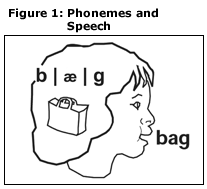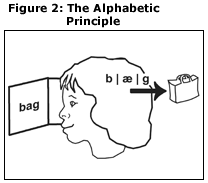Reading is the process by which a person gets information from written symbols such as letters, characters, and words. A person can read using sight or touch, such as when a vision-impaired person reads braille. Reading disorders occur when a person has trouble reading words or understanding what they read.

Reading and Reading Disorders
Reading is an important skill for communication, education, and most types of work. Reading disorders interfere with people’s ability to read and affect how they learn to read. NICHD conducts and supports a variety of research aimed at understanding the process of reading, the mechanisms of reading disorders, and the best ways to help people who struggle with reading.
About Reading and Reading Disorders
How does reading work?
What is the best way to teach children to read?
The NICHD-led National Reading Panel, formed by Congress in the late 1990s, reviewed decades of research about reading and reading instruction to determine the most effective teaching methods. The panel found that specific instruction in the major parts of reading (phonemic awareness, phonics, fluency, vocabulary, and comprehension) is the best approach to teaching most children to read. Instruction should also be systematic (well-planned and consistent) and clear. These findings on reading instruction are still relevant today.
Watch our video and learn what NICHD research is teaching us 
There are multiple ways to teach and learn reading. Some methods work better than others, and some readers learn better from one method than they do from another. Reading aloud is considered the best way for caregivers to prepare a child to learn to read.1
The panel’s analysis showed that the best approaches to reading instruction have the following elements:2
- Explicit instruction in phonemic awareness
- Systematic phonics instruction
- Methods to improve fluency
- Ways to enhance comprehension
Since the panel’s report, NICHD-supported researchers have built on the panel’s findings. For example, new discoveries shed light on how learning changes the brain and how to teach most effectively. Learn more about these and other research findings in NICHD Looks Back on 50 Years of Learning Disabilities Research.
Additional findings are listed in NICHD’s news items related to reading and reading disorders.
What are reading disorders?
Reading disorders occur when a person has trouble reading words or understanding what they read. Dyslexia is one type of reading disorder. It generally refers to difficulties reading individual words and can lead to problems understanding text.
Most reading disorders result from specific differences in the way the brain processes written words and text.1 Usually, these differences are present from a young age. But a person can develop a reading problem from an injury to the brain at any age.
People with reading disorders often have problems recognizing words they already know and understanding text they read. They also may be poor spellers. Not everyone with a reading disorder has every symptom.
Reading disorders are not a type of intellectual or developmental disorder, and they are not a sign of lower intelligence or unwillingness to learn.
People with reading disorders may have other learning disabilities, too, including problems with writing or numbers. Visit our topic on learning disabilities for more information about these problems.
Types of Reading Disorders
Dyslexia is the most well-known reading disorder. It specifically impairs a person’s ability to read. Individuals with dyslexia have normal intelligence, but they read at levels significantly lower than expected. Although the disorder varies from person to person, there are common characteristics: People with dyslexia often have a hard time sounding out words, understanding written words, and naming objects quickly.1
Most reading problems are present from the time a child learns to read. But some people lose the ability to read after a stroke or an injury to the area of the brain involved with reading.2 This kind of reading disorder is called alexia.
Hyperlexia is a disorder where people have advanced reading skills but may have problems understanding what is read or spoken aloud. They may also have cognitive or social problems.3,4
Other people may have normal reading skills but have problems understanding written words.5
Reading disorders can also involve problems with specific skills:
- Word decoding. People who have difficulty sounding out written words struggle to match letters to their proper sounds.
- Fluency. People who lack fluency have difficulty reading quickly, accurately, and with proper expression (if reading aloud).
- Poor reading comprehension. People with poor reading comprehension have trouble understanding what they read.
What are the symptoms of reading disorders?
People with reading disorders often have different combinations of symptoms.
- Problems sounding out words
- Difficulty recognizing sounds and the letters that make up those sounds
- Poor spelling
- Slow reading
- Problems reading out loud with correct expression
- Problems understanding what was just read
How are reading disorders diagnosed?
Providers usually use a series of tests to diagnose a reading disorder. They assess a person’s memory, spelling abilities, visual perception, and reading skills. Family history, a child’s history of response to instruction, and other assessments might also be involved.1
Although NICHD studies reading and reading disorders, the institute is not involved with setting definitions or guidelines for diagnosing reading disorders.
The U.S. Department of Education offers services and assistance for people with reading disorders through its Office of Special Education Programs (OSEP).
OSEP also supports the Center for Parent Information & Resources 

The organization Understood 

What causes reading disorders?
Reading disorders involve specific, brain-based difficulties in learning to recognize and decipher printed words. There is no single known cause at this time.1
Environmental factors—such as children’s experiences in the classroom or whether they were read to often as preschoolers—can play a significant role in reading ability.
In addition, research suggests that difficulty with reading may be linked to a person’s genes. This finding means that reading disorders can pass from one generation to the next. For example, some cases of reading disorders are associated with a change in genes that play a role in prenatal brain development.1
What are common treatments for reading disorders?
The best treatment strategy for a reading disorder depends on the needs of the individual. In general, teachers with special training provide the most effective instruction. The instruction should be intensive. And the earlier children receive help, the better the results.
Reading disorders cannot be “cured.” But with proper instruction, people with these disorders can overcome specific problems, learn to read, and improve fluency and comprehension.1
There is no single treatment for reading disorders. The following sources provide reliable information about the many treatment options available:
- U.S. Department of Education (ED), Institute of Education Sciences: What Works Clearinghouse
- ED, Office of Special Education and Rehabilitative Services
- International Dyslexia Association: Dyslexia Handbook: What Every Family Should Know
Read more about educational treatments for children with reading disorders and other types of learning disabilities at NICHD’s Learning Disabilities A to Z webpage.
 Spoken words are made up of smaller pieces of sound—called phonemes.
Spoken words are made up of smaller pieces of sound—called phonemes. In alphabetic languages such as English, another part of learning to read is understanding that letters of the alphabet stand for sounds or phonemes. A phoneme can correspond to one letter or a group of letters. This knowledge is called the alphabetic principle (Figure 2).
In alphabetic languages such as English, another part of learning to read is understanding that letters of the alphabet stand for sounds or phonemes. A phoneme can correspond to one letter or a group of letters. This knowledge is called the alphabetic principle (Figure 2). BACK TO TOP
BACK TO TOP